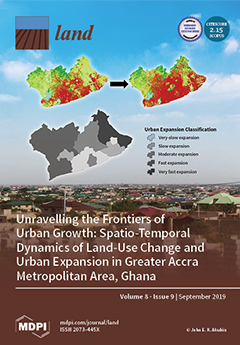Resources
Displaying 1666 - 1670 of 2258Predicting Urban Expansion and Urban Land Use Changes in Nakhon Ratchasima City Using a CA-Markov Model under Two Different Scenarios
This study focused on the prediction of land-use changes in Nakhon Ratchasima city using a CA-Markov Model with GIS. Satellite images taken by Landsat-5 (1992), Landsat-7 (2002) and THEOS (2016) were used to predict land use in 2026. In 1992, the most proportion of land usage was built-up areas (47.76%) and followed by green areas (37.45%), bare lands (13.19%), and water bodies (1.60%), respectively. In 2002, the land use comprised built-up areas (56.04%), green areas (35.52%), bare lands (4.80%) and water bodies (3.63%).
Land and Landscape; Linking Use, Experience and Property Development in Urban Areas
This article brings together the concepts of land and landscape, tightly linked in urban transformative situations, but rarely used for the purpose to strengthen strategic planning for sustainability. They are investigated as a combined base for land use deliberations, in early phases of planning processes, in practices of different scale, especially in a European context, drawing on planning and landscape policies generally agreed upon, as well as the UN Sustainable Development Goals.
Designing a Blue-Green Infrastructure (BGI) Network: Toward Water-Sensitive Urban Growth Planning in Dhaka, Bangladesh
In a warming world, urban environmental stresses are exacerbated by population-increase-induced development of grey infrastructure that usually leaves minimal scope for blue (and green) elements and processes, potentially resulting in mismanagement of stormwater and flooding issues. This paper explores how urban growth planning in the megacity of Dhaka, Bangladesh can be guided by a blue-green infrastructure (BGI) network that combines blue, green, and grey elements together to provide a multifunctional urban form.
Participatory Mapping in a Developing Country Context: Lessons from South Africa
Digital participatory mapping improves accessibility to spatial information and the way in which knowledge is co-constructed and landscapes co-managed with impoverished communities. However, many unintended consequences for social and epistemic justice may be exacerbated in developing country contexts. Two South African case studies incorporating Direct-to-Digital participatory mapping in marginalized communities to inform land-use decision-making, and the ethical challenges of adopting this method are discussed.
Controversial Connections: The Water-Energy-Food Nexus in the Blue Nile Basin of Ethiopia
The article takes hydro-development schemes in the Upper Blue Nile Basin of Ethiopia as an example to discuss the suitability and shortcomings of nexus approaches for the analysis of complex socio-ecological transformations. Based on critical theoretical debates and extensive field research in Ethiopia, the paper broadens the nexus perspective by integrating the three analytical dimensions of time, space, and power.


